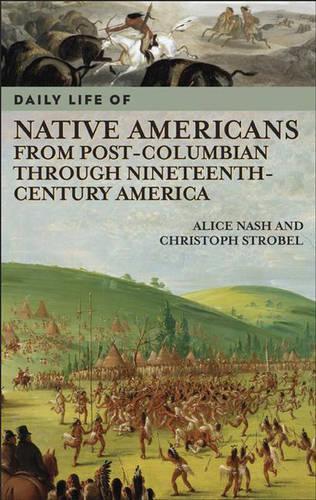
Daily Life of Native Americans from Post-Columbian through Nineteenth-Century America
(Hardback)
Available Formats
Publishing Details
Daily Life of Native Americans from Post-Columbian through Nineteenth-Century America
By (Author) Alice Nash
By (author) Christoph Strobel
Bloomsbury Publishing PLC
Greenwood Press
30th June 2006
United States
Classifications
General
Non Fiction
Social and cultural anthropology
970.00497
Physical Properties
Hardback
312
Width 156mm, Height 235mm
595g
Description
When Columbus discovered America in 1492, there were over five hundred indigenous groups living in what is now the United States. Despite the breathtaking diversity and inventiveness of these peoples, the culture, customs, and history of Native Americans are relatively unknown to many students and general readers today. In ten narrative chapters, organized by geographical region, Nash and Strobel examine the real history of Native Americans. How did Natives interact with European settlers Did they really have pow-wows Where did Indian children go to school Did chiefs really wear feathered headdresses and smoke peace pipes Dispelling the myths and stereotypes, the day-to-day lives of these tribes and groups during a time of tremendous change is discussed. Chapters include details of daily life such as: clothing; colonization; education; farming & hunting; households & homes; leadership & political power; spirituality, rituals & customs; trade & alliance; warfare; women's & children's roles. Readers will learn the other history of indigenous people; not what is told in many history books, or seen in Hollywood movies and old westerns. When Columbus discovered America in 1492, there were over five hundred indigenous groups living in what is now the United States. Despite the breathtaking diversity and inventiveness of these peoples, the culture, customs, and history of Native Americans are relatively unknown to many students and general readers today. In ten narrative chapters, organized by geographical region, Nash and Strobel examine the real history of Native Americans. How did Natives interact with European settlers Did they really have pow-wows Where did Indian children go to school Did chiefs really wear feathered headdresses and smoke peace pipes Dispelling the myths and stereotypes, the day-to-day lives of these tribes during a time of tremendous change is discussed. Chapters include details of daily life such as: clothing; colonization; education; farming & hunting; households & homes; leadership & political power; spirituality, rituals & customs; trade & alliance; warfare; women's & children's roles. Readers will learn the other history of indigenous people; not what is told in many history books, or seen in Hollywood movies and old westerns. Greenwood's Daily Life through History series looks at the everyday lives of common people. This book will illuminate the lives of this indigenous group and provide a basis for further research. Black and white photographs, maps and charts are interspersed throughout the text to assist readers. Reference features include a timeline of historic events, sources for further reading, glossary of terms, bibliography and index.
Reviews
Arranged geographically, starting with the Eastern Woodlands and working west, this volume tells the story of peoples constantly adjusting to the ever-more-pressing dangers and adversity of encroaching white settlement in their lands. It also examines the strain experienced by Native Americans while trying to maintain a semblance of normal daily life in the face of change. Extensive notes, bibliography, chronology, illustrations, and primary-source documents supplement the fine text. * Curriculum Connections School Library Journal *
The Native American story is one of constant adjustments to ever-more-pressing dangers and adversity. And in that respect it is similar to the story of Europeans during the era of the Black Death. Both books expertly portray the lives of peoples under enormous strain to maintain a semblance of the normalcy implied by the term daily life. Each volume comes with a full complement of strong scholarship, including extensive notes, bibliographies, chronologies, illustrations, and excerpts from original sources. The prose and general composition suggest a laudable and consistently high level of editing. These volumes are both recommended for teens with strong reading skills and a background in history. (Reviewed with Daily Life during the Black Death) * School Library Journal *
Aimed at high school students and general readers, this text offers a glimpse of daily life in Native North America from Columbus' first voyage in 1492, to the end of the 19th century. Rather than attempt a comprehensive overview of some 500 nations, the authors focus on just a few groups in each of the main culture areas of the continental U.S. (e.g. the Iroquois Confederacy, the Great Plains). B&W drawings and historical photographs illustrate the volume. * Reference & Research Book News/Art Book News Annual *
Author Bio
ALICE NASH is Associate Professor of Native American and Early American History at the University of Massachusetts-Amherst. Her research interests center on the impact of colonization on the indigenous peoples of northeastern North America with a particular focus in family and gender relations. She is the author of Spirit, Power and Protocol: Wabanaki Histories to 1800 (forthcoming) CHRISTOPH STROBEL is an Assistant Professor of History at the University of Massachusetts Lowell. He teaches courses in world, Native American, African, and Middle Eastern history. Much of his research and writing deals with issues of race and colonization.
